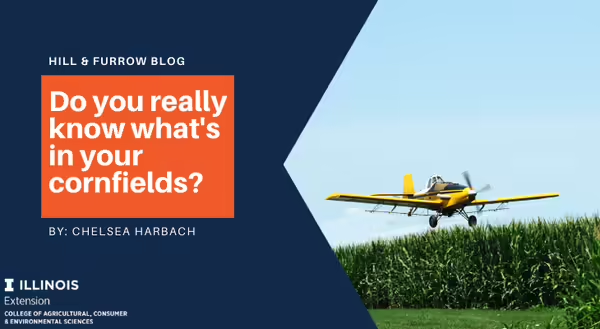
This article was also submitted to AgriNews.
Cornfields across the state are at or nearing tassel, which means it is time to begin planning those fungicide applications to help manage fungal diseases. Before you spray, have you stopped to check what's in your cornfields?
Before a fungicide application, it is vital to scout your corn for disease. As you know, corn is susceptible to numerous diseases, so having a basic understanding of the disease presence and pressure in your field is a must. Once you have scouted your field in a few areas, you can feel confident in your management decisions.
If most of the disease you are finding in your field has a bacterial pathogen culprit, such as bacterial leaf streak, Stewart's wilt, or Goss's wilt, then a fungicide application will be pointless. Fungicides only control fungal diseases. Be sure that you've positively identified a fungal disease, such as northern corn leaf blight, common rust, or grey leaf spot. If you are uncertain of the cause of any disease symptoms you observe in your fields, you can send samples to the University of Illinois Plant Clinic for identification! (web.extension.illinois.edu/plantclinic)
You should also have an idea of the disease history in the field. Many fungal pathogens can overwinter (survive) on debris or in the soil. So a field with a known history of such disease would be the right candidate for a fungicide application.
Take, for example, tar spot caused by the fungal pathogen Phyllochora maydis. This disease appeared in the United States in 2015, and 2018 saw disease on an epidemic proportion throughout much of Illinois. Researchers raced to determine if the pathogen could overwinter in the north central region of the United States. Scientists across the Midwest have confirmed that P. maydis can overwinter in corn debris. So if you have a field with a history of tar spot and the year has been conducive to disease development, you will likely want to plan on a fungicide spray.
One of the most economically and ecologically friendly methods to manage disease in field crops is to plant disease-resistant varieties. As such, you likely have some resistance to various plant diseases already present in your cornfield. If you are uncertain, you can use the internet to find disease ratings for your hybrids or talk to your seed dealer for that information.
Fungicide sprays are usually not advised for hybrids with "built-in" disease resistance. If you have a field that is susceptible to a disease of concern, you will definitely want to consider fungicides when you find symptoms on the third leaf below the ear on at least 50% of the plants. As disease resistance is generally not an "all-or-nothing" deal, you may find that you have planted a hybrid with an intermediate level of resistance. This means that the hybrid will be able to "fight off" the disease to some degree, but it will likely show more symptoms and have more yield suppression than a resistant hybrid. For hybrids planted with an intermediate level of resistance, a fungicide application may be warranted if the following conditions are met:
- The fungal disease occurs on the third leaf below the ear or higher on at least half of the plants.
- Approximately one-third of the ground is covered with corn residue from previous years.
- The weather has been or is forecasted to be favorable to the development of foliar fungal diseases.
All of these precautions prior to fungicide spray are intended to help avoid unnecessary sprays and the development of fungicide-resistant pathogens. Contact any Commercial Ag Extension Educator or Nathan Kleczewski, Extension Field Crops Pathologist, with any additional questions.